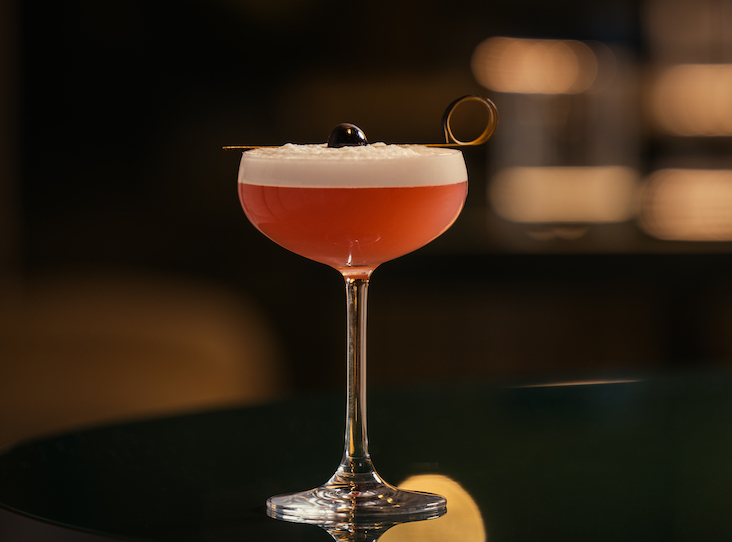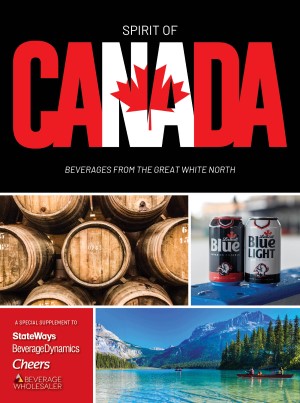Saké, that most misunderstood grain-based beverage alcohol, is slowly grabbing the attention of cutting-edge bar and restaurant operators.
Some restaurants, especially those with an Asian, fusion or Pacific Rim food connection, are following the lead of upscale Japanese operations like the elegant Inagiku in NYC’s Waldorf-Astoria and Genji in Philly’s Ritz-Carlton lobby, devoting space on their menus and some promotional energy to making quality sake part of their signature style. These operators are hunting down better and wider selections of artisanal varieties of sake, offering them in tasting portions or in “flights,” and suggesting on their menus dishes that go best with various brands. They’re also taking on what could be the most difficult task, teaching misinformed Americans that most premium sakes are better served chilled.
NYC’s Inagiku offers quality sakés in a traditional setting.
At places like SF’s Park Grill Bar, sakes have started slowly to build a specialized clientele for the more complex and refined sakes. And while you would expect to find fine varieties served at such upscale operations, they’re not the only suitable model. In Manhattan’s East Village, the underground bar Decibel, frequented by trend-conscious Gen Xers, New York-based Japanese and Japanese travelers, has been doing bang-up business with its stock of more than 50 types of sake.
Some restaurants have turned to sake for help in cocktail creativity. Philadelphia’s Buddakan, a high-energy temple of modern Asian cuisine, features drinks like the Geisha in a Sidecar (sake replaces triple sec or Cointreau in the traditional Sidecar recipe), the Shanghai Spritzer (sake, plum wine and red wine, garnished with a pickled plum) and the Sake Tenpai Martini (sake and barley vodka, chilled and served up, garnished with sliced cucumber.)
Nice Rice
On its own, sake has found some friends in many new places.
“Sake offers a great guest experience as an alternative to wine for our guests,” says Tim McGregor, director of food & beverage at SF’s Park Hyatt Hotel and its restaurants, Park Grill and Park Grill Bar.
Even though the Hyatt is a major hotel with a high-end clientele, few of their regular clients knew much about sake before McGregor introduced the premium brands. And almost none had ever consumed their sake chilled, the serving temperature preferred, in most cases, by sake connoisseurs.
Philly’s Buddakan markets high profile saké cocktails in a modern setting with Asian cuisine.
To get local business people more aware of sake’s qualities, McGregor invited them to a Japanese food and sake reception. The result was encouraging. “People were just astounded how good the chilled sakes were. And they didn’t know anything about how good they could be or that they were so good chilled.”
Other operations have employed sake to spruce up their image.
“We were looking for something to energize the lobby lounge,” says Michelle McGraw, beverage coordinator at Philly’s Ritz-Carlton. “Ritz-Carlton lobby bars have the reputation for being quiet and laid back, but we wanted to try for something more exciting and upscale.”
Picking quality sake as the method to attract attention has helped the hotel make a mark in Philadelphia as the place to learn about the beverage. Genji’s lobby combination of sake and sushi has become so popular that private reception customers routinely request the pair as component for their events.
“People have this image of sake as being something warm and yucky you might have drunk in the ’70s, but their reaction is very good,” she says.
After a $1.3 million renovation in 1997, Inagiku spruced up its menu as well, featuring premium sakes both on the beverage menu and paired with individual dishes on the food menu. As a result, manager Masayuki Shimura has slowly established a reliable premium sake clientele
“We serve many Americans as well as Japanese people who are interested in trying premium sakes like these and need to have more information. That’s why we give them an idea of what kind of food categories go best with them. And even Japanese guests find that information useful, because they may not know much about these sakes.
On his menu, Shimura pairs sakes with foods; lobster tempura with a light and smooth Akita Homare; sashimi with big flavored Umenishiki; or yellowtail teriyaki with rich and fragrant Tsukasabotan.
Priced from $7.50 to $18.00 per glass, the sakes are also sold by bottle, and range from $38 for 500 ml of Umenishiki to $95 for the larger bottles of Hakkaizan. Sake by the glass is priced about the same as grape wines.
“Since we have introduced on the menu which sakes go with what food, we are selling more. It used to be only Japanese guests who would order them.”
Shimura has made sake matching dinners available for small groups in some of the Inagiku private rooms; he’s about to introduce a sake dinner that will include a sake lecture and matchings. “Many of my guests have asked me to do this for their small groups, and now I’d like to offer it more widely.”
What kind of rice and how much it has been polished is very important to the ultimate taste of the sake. Shimura offers a peak at a sample of polished rice he’s recently received from a sake manufacturer–the grains of rice are tiny and almost pearl-like, looking more like enormous grains of sand than rice, having been polished to remove about 70% of their volume. The more polished the rice, the more pure the sake.
At Buddakan, opened late last year, the customer response for sake in a contemporary Asian setting has been good for the premium sakes, according to bar manager Rose Parrotta and general manager Michael Vahey. But they’ve discovered resistance to drinking premium sakes cold. “In many cases, people prefer to have them only hot,” says Vahey. “We try to educate them a little about how premium sakes taste better cold, but you can only push the issue so far. If they want it hot, we indulge them.”
Sake sales ebb and flow at Buddakan. As with champagne, groups are more likely to order sake than singles or couples. Sake flights, however, are more reliant on hand-selling at the bar. And to instruct his staff on the beverage, Vahey brought in a local sake expert.
Help from sake makers is available as well; Japanese manufacturer Ozeki trained the Ritz staff on, among other things, the meaning of the sake numeric value, indicating the range of relative sweetness (-10) to dryness (+10).
In most cases, sake remains in the teaching tool stages, with guests asking many questions; getting the information to restaurateurs is the first step, in many cases, in making sure the customer learns the difference between varieties.
Sake Time
Yoshi Yumoto, national sales manager at Sidney Frank Importing for Gekkeikan sake, which is produced both in Japan and the U.S., estimates a 40% annual increase for the premium end of the sake business. And that’s not just high-end Japanese restaurants. “We see more and more non-Asian clients serving sake,” he says. At a recent Washington, D.C., wine-tasting event, Yumoto spoke with two curious restaurant owners, one Italian and the other French. “They had read about sake but didn’t know very much about it. After tasting some, they’re putting the premium varieties on their wine lists.”
Gekkeikan, which offers operators training videos on the manufacture and varieties of sake, is betting on increased US interest in premium sakes by introducing a California–produced premium variety, called Haiku.
Grif Frost, ceo of US-based sake maker JABC, says Asian or fusion restaurants are the most receptive for premium sake, but sees promise in vegetarian and seafood restaurants as well. Natural food fans will like sake, Frost says, because it contains no sulfites and, reputedly, produces no hangover, though there’s little scientific evidence for that claim. “We expect that one day in the not too distant future that any restaurant with a wine list will have a number of sakes listed as well,” he says.
The key challenges? Frost says availability of fresh, premium sake and lack of knowledge provide the two biggest hurdles.
JABC is now focused on getting their Oregon Momokawa Premium Sakes to distributors and educating sales reps. “The next step will be sake seminars designed for restaurateurs and bartenders, followed by advertising in media which reaches this group,” he says. In the meantime, JABC has offered a four glass sampler tray promotion to restaurateurs.
John Gautner, author of a Japan-based sake newsletter and The Sake Handbook, says sake’s reputation is undergoing a renaissance in its homeland, too.
“As centuries of experience comes to a head, better sake is being made then ever before. However, sake is losing a marketing war to red wine now. Beer has long been the most consumed beverage in Japan. Some predict that premium sake in general, and boutique, will make a resurgence this year.
“Until the 1970s, however, good sake was not available on a large scale because it was not considered economically viable by the brewers. I know that a lot more good sake from Japan will become available to consumers in the U.S. soon. Hopefully prices will be kept down low enough to allow the interest to get a real foothold.”
Grain Expectations
While Americans primarily know sake as a hot beverage, most quality sakes don’t benefit from the method, says Shimura. Sake is served hot in Japan during the winter, but that’s primarily the lowest grades of sake. The complex flavors and aromas of quality are destroyed by overheating. Most are meant to be served cold or slightly chilled.
Shimura says while heating does benefit some rich, and full-bodied sakes, the lighter, more floral or fruity varieties ought not be heated at all. “Heated, these are more like water, and they lose their flavor,” he says.
Some restaurant guests expect their sake to be served in small decanters called tokkuri and poured into the small ceremonial choko. At the Ritz-Carlton, they’re instead served 3- and 5-ounce portions (and charged anywhere from $2 to $11.50) in wine glasses. The choko is considered awkward by guests, says McGraw. “Stocking the additional containers would crowd the bar. And the glasses allow better aeration from swirling the sake, something knowledgeable customers like to do with their beverages.”
Although some places depend on Japanese and Asian guests, the Ritz is seeing primarily local and hotel guests looking for a quality experience. “The guests appreciate the quality of the beverage and like the upscale thing.”
The Park Grill and Bar promotes the wines two ways. McGregor offers sake on the bar list matched with small snack-like dishes and two sake flights, consisting of three or four servings of 1.5-ounces, priced at $9 and $13. And while the wine-by-the-glass list mentions 11 still and three sparkling wines, only the sakes receive the loving description usually connected with California wines, a sign of great potential in the now tiny category.
“Each sake we have chosen has its own unique style and character. When consumed with food, sake enhances the original flavor of food ingredients and at the same time its own flavors can be enjoyed even more.”
Individual sakes get even better treatment. Ohyama is described as “The sake of love, this soushu sake from Yamagata is light and dry, which makes it a wonderful aperitif” and Ichinokura “is characterized by the harmony of smooth flavor and the refreshing aroma of Japanese cedar, which enhances the flavor. It is full-bodied with a well-balanced bittersweet quality and goes well with heartier foods.”
For more about saké, go to the Cheers website at www.cheerstest.wpengine.com




